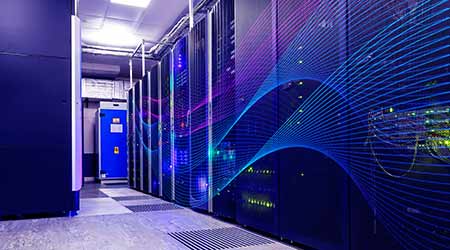How Common is Liquid Cooling for Computers?
Understand the difference between chilled-water computer room air-handling units (CRAHs) and liquid cooling for computers, and reap the energy savings rewards.
Liquid cooling for data centers is extremely common. Any data center that uses chilled-water computer room air-handling units (CRAHs) is essentially using liquid cooling. The piping distribution, valves, joints, elbows, etc., are the same as the ones used for liquid-cooled computers. The biggest difference between a data center that uses chilled-water CRAHs and one that uses liquid cooling for computers is that, for the latter, the liquid is located within inches of the IT equipment.
Historically this has been one of the biggest concerns for data center operators, hindering wider acceptance of liquid-cooled computers. To address this issue, manufacturers of liquid cooling systems have developed products that allow for easy installation and removal using quick-connect, dripless couplers. And from the IT equipment side, using liquid-cooled computers increases the longevity and reliability of the computers by reducing (or eliminating) the need for IT fans, which reduces vibrational failure of other internal components. Finally, liquids have a greater thermal mass than air, allowing for greater stability of chip temperatures, which enhances reliability. While traditional air-cooled data centers (or portions thereof) will be around for quite some time, the speed and intensity of computing advancements will require alternative approaches such as liquid cooling.
Liquid cooling applications today
While liquid-cooled computers are used in many data center types, the highest concentration of liquid cooling is in the high-performance computing and super-computing segments. Looking at power per cabinet, these high-performance computing systems are typically one to two orders of magnitude greater than a typical enterprise data center. In addition to the extremely high power demand, these cabinets will be clustered into a very small space to reduce latency of the data transmissions. This translates into an exceedingly dense installation requiring extremely precise and effective cooling systems. This can only be accomplished with liquid cooling. (The use of liquid cooling for super-computers goes back decades, so the operators of this data center type are very familiar with the technology). Typically, over a period of a few years, super-computing technology trickles down to enterprise data centers, driving the need for cooling systems that perform beyond what is used today for high-density enterprise systems.
Energy use
Energy-use reduction is one of the most attractive aspects of cooling computers directly with liquid. An air-cooled data center requires colder ambient temperatures to compensate for unintended recirculation around the cabinets and to offset inefficiencies in heat removal from the computer’s internal components. This is a kind of “safety factor” to ensure proper cooling, minimizing the chance of thermal overload resulting in a hard shutdown and protecting the computer from damage.
In contrast, liquid cooling captures the heat generated by the computer directly at the source (central processing unit, graphics processing unit, memory modules), eliminating the need for a safety factor. As a result, using much higher liquid temperatures will keep the computers operating at optimal conditions and will reduce energy use compared to an air-cooled computer.
Using higher temperatures has a two-fold advantage. First, when vapor compression cooling is used, the increased supply water temperature (evaporator temperature) results in a decrease in the compressor power. Second, because the liquid temperature is higher, aggressive economization strategies can be used to minimize or eliminate the need for vapor compression cooling (such as chillers). Depending on the chosen liquid temperature, using cooling towers or fluid coolers alone will maintain the liquid temperature. In some cases vapor compression equipment can be eliminated entirely, reducing first cost and space requirements.
Energy modeling shows the differences in energy consumption between air-cooled and liquid-cooled designs. These models examine two locations, Helsinki and Houston. The results show the significant reductions in energy consumption when using the liquid-cooled systems.
Historically, water cooling in the data center has had difficulty getting traction with some data center owners and operators. However, there is a renewed emphasis on the merits of liquid cooling, primarily to reduce costs but also to support the incredible new advances in computational hardware that are being developed. The time could well come when liquid cooling will be the dominant form of thermal control for computing systems.
Related Topics:















